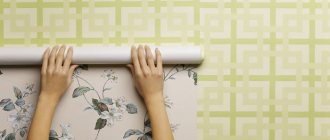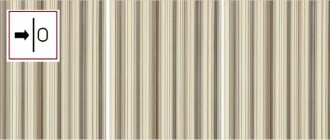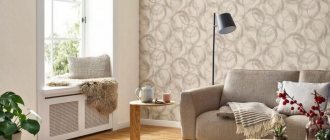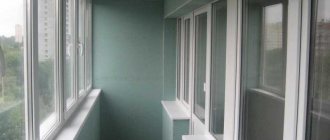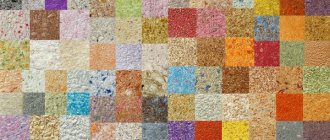SHARE ON SOCIAL NETWORKS
FacebookTwitterOkGoogle+PinterestVk
The desire to make repairs and update the appearance of walls always begins with the choice of material. In the vast majority of cases, this is wallpaper. However, the most common problem is not deciding on their color and texture, but rather not making a mistake with the number of rolls. Therefore, it is important to know how to calculate the wallpaper for a room so that you don’t have to buy additional material or store extra, complaining about wasted money.
By correctly calculating the number of rolls of wallpaper, you can avoid unnecessary problems when pasting walls.
What determines the number of wallpapers?
From the size of the room (more on this below) and from the design. One roll is usually 10 meters. If the wallpaper is plain and the ceiling height is 2.5 meters, you can cut the roll into four strips. If the drawing has to be adjusted, there will be three stripes.
Free docking
stroyday.ru
There is no matching of patterns: the roll is simply cut into the required number of panels. Usually these are plain wallpapers, wallpapers with abstract patterns or vertical stripes.
Direct docking
stroyday.ru
The drawing will have to be combined horizontally so that adjacent stripes begin with the same elements. And here everything will depend on the height of the repeat - the distance through which the pattern is repeated (indicated on the label). In the worst case, you will have to throw away almost the entire height of the repeat, so when calculating it must be added to the height of the ceiling.
Offset docking
stroyday.ru
The drawing is located diagonally, so each canvas moves. As a rule, half rapport. In this case, you need to add the repeat height and the offset value to the ceiling height: you will find both numbers on the label.
Instructions for using the calculator
The calculator for calculating the number of wallpapers has various fields:
- Room dimensions
- Room width
- Room length
- Room perimeter
- Ceiling height
- Doors windows
- Number of doors
- Door height
- Door width
- Number of windows
- Window height
- Window width
- Wallpaper options
- Roll length
- Wallpaper width
- Repeat pattern
- Shifted drawing
- Leveling margin
- Calculate button
- Calculation results
- Number of wallpapers
- Number of rolls
How to calculate the amount of wallpaper using tables
This is an ideal method if the room is square or rectangular and the wallpaper does not require adjustment. All you need is the area of the room and the height of the ceiling.
Calculation of the number of narrow wallpapers (width – 53 cm, length – 10 meters).
remont-otdelka-m.ru
Calculation of the amount of wide wallpaper (width - 106 cm, length - 10 meters).
remont-otdelka-m.ru
Calculation table
If all of the above calculation methods are complex, a table will help in calculating the finishing material. To use it, you need the key indicators discussed above: area (length multiplied by width) and height. The process of calculating wallpaper is labor-intensive: you need to take into account many nuances, which in the end may turn out to be decisive.
No matter how carefully they calculate the finishing material, the craftsmen advise purchasing another one additionally. This will be relevant in the case when, during repair work, a cut gets dirty or dented, and it will be impossible to fix it. In an apartment where children live, an additional roll may be useful for unplanned repairs.
Are you planning a renovation? Read our articles about the types of wall coverings and how to choose wallpaper for various rooms, including the kitchen and bedroom, as well as how to hang them correctly.
How to calculate the number of wallpapers mathematically
If the room has a complex shape, there are bends and niches, it is better to count along the perimeter. To do this, you need to add up the lengths of all the walls. Window and door openings less than 60 cm wide are considered a flat wall; wider ones are excluded from the calculation. The resulting value is rounded up.
Example: 2.75 m + 3 m + 0.4 m + 2.85 m + 4 m + 0.65 m = 13.65 m ≈ 14 m.
Then you need to determine the number of strips: divide the perimeter by the width of the roll. Let's return to our example: 14 m / 1.06 m = 13.2. Rounding up - 14 wide wallpaper sheets. For narrow wallpaper: 14 m / 0.53 m = 26.4. That is 27 stripes.
Now you need to determine how many strips can be obtained from one roll: the length of the roll must be divided by the length of the strip. And there can be three options:
- If the wallpaper does not require adjustment, the length of the strip is equal to the height of the ceiling. 10 m / 2.75 = 3.6 ≈ 3.
- If the wallpaper is directly joined, the length of the strip is equal to the sum of the ceiling height and the repeat height (0.6 m). 10 m / (2.75 + 0.6) = 2.9 ≈ 2.
- If the wallpaper is jointed, the length of the strip is equal to the sum of the ceiling height, repeat height (0.6 m) and offset value (0.3 m). 10 m / (2.75 + 0.6 + 0.3) = 2.7 ≈ 2.
The last step: divide the number of strips we need by the number of strips in the roll. If the wallpaper is wide, 14 will need to be divided by 3 or 2. If it is narrow, divided by 3 or 2 will need to be 27 stripes.
How to measure walls for gluing and make the necessary calculations?
There is no difficulty in the calculations, so we arm ourselves with a notepad, a pen and remember the school curriculum in geometry for grade 6, perhaps use an online calculator.
Advice
Formula for finding wall area: Swalls = Prooms x Hrooms , where
- S is the area of the rectangular wall surface;
- P —perimeter;
- H - height.
You need to approach room measurements with all responsibility, because the amount of money spent and the quality of repairs depend on them. Let's make the calculation:
- First, we take measurements (we convert the centimeters obtained during the measurement into meters). For example, if the length of the room is 560 centimeters, then we count 5.6 meters.
- Length - 5.6 meters.
Width - 3.2 meters.
- Let's calculate the perimeter - it is equal to the sum of all sides.
P = (a+b) x 2, where a and b are the sides.We find: (5.6+3.2)x2=17.9 meters. Perimeter P = 17.9 m.
- Determining the height. From the highest point of the wall, plumb down to the lowest point of the wall. It turns out 2.5 meters. H = 2.5 m.
- Using the formula indicated earlier, we calculate the area of the walls: Swalls = Prooms x Hrooms Swalls = 17.9 x 2.5 = 44.8 m2 The area of all walls for pasting is 44.8 m2.
- From the resulting number, it is necessary to subtract window, balcony blocks (if any) and doorways, since there is no need to glue wallpaper there.
We have one window in our room, the area of which is calculated according to the same scheme. It is equal to 1.8 m2 (1.25m x 1.45m). Door surface - 1.36 m2 (0.70 m x 1.95 m). The total area of surfaces not involved in gluing is 3.16 m2. The net area is calculated as follows: 44.8 – 3.16 = 41.6 m2.
Attention
If the room has a non-standard size, a shape other than rectangular, calculations should be made separately for each wall, and then add up the results.
How to calculate the number of wallpapers using services and applications
The fastest way if you know the parameters of the room, and the simplest if you are not good with mathematics. There are many wallpaper calculators on the Internet, here are just a few good ones.
- Wallpaper calculator from calc.by. It calculates both by area and by perimeter, allowing you to exclude door and window openings from the calculation. You can also set the width and footage of the roll.
- Wallpaper calculator from calc.ru. Performs calculations along the perimeter. Helps determine how much wallpaper and glue is needed.
- Wallpaper calculator from remont-online.com. First, the configuration of the room is selected, then the width of the walls and wallpaper is set. You can also specify the price per roll to find out the total cost of the pasting.
If you are already in the store, use the application for calculations. Here are two free ones with good ratings.
appbox fallback https://apps.apple.com/ru/app/647609314
Construction calculator - calculation of materials
Will Maze
Price: Free
Download
Price: Free
Why keep a roll for spare?
A spare roll of wallpaper for the room can save the situation if the initial calculations turn out to be incorrect. Pet owners or new parents will also appreciate their foresight in the event of damage to the coating.
Should windows and doors be “subtracted”?
When calculating the total area, door and window openings must be taken into account. As practice shows, in places above a door or window, the remaining small pieces will be used, but there is simply no need for the whole canvas.
Should I wallpaper behind furniture?
Reasonable savings never hurt, therefore, it is necessary to clarify two details.
- First: is there a reshuffle planned in the future? If the possibility cannot be excluded, it is better to play it safe than to start repairs again in a couple of years. An exception is gluing the walls behind the kitchen unit, built-in wardrobe and other permanently located furniture.
- The second important point: is the savings justified? Sometimes it’s easier to cover the entire room at once. And saving one or two rolls is unlikely to have a significant impact on the overall cost of repair work.
Free docking
Used for products with small and asymmetrical patterns. The canvases can be glued in any order; there is no need to match the pattern or maintain the direction of the canvas. This type can be easily calculated by the area of the walls, leaving one roll in reserve for unaccounted pieces for gluing over windows and doorways.
Direct docking
Canvases of this type do not need to be shifted to align the pattern; the pattern is symmetrical. Calculating the quantity is quite simple by determining the total area of the room.
Is it possible to return excess wallpaper to the store?
Article 25 Article 25. The consumer’s right to exchange goods of proper quality under the “Law on the Protection of Consumer Rights” provides for the return of all purchased goods if they do not match the style or color. And subject to a number of conditions.
- Wallpaper was sold in rolls, not by the meter. The list of NON-FOOD PRODUCTS OF GOOD QUALITY, NOT SUBJECT TO RETURN OR EXCHANGE FOR A SIMILAR GOODS OF OTHER SIZE, SHAPE, SIZE, STYLE, COLOR OR EQUIPMENT of non-food products of proper quality, not subject to return or exchange, includes finishing materials. But we are talking only about goods sold by the meter.
- The wallpaper remained unopened, not wrinkled or scratched.
- No more than 14 days have passed since the date of purchase. When purchasing online – 7 days.
- There is a receipt or other document confirming the fact of purchase. If the receipt has not been saved, you can request a cash register tape (stores keep it for a month) or attract witnesses.
In other words, if you don't like the wallpaper, you can take it back to the store. All rolls. In this case, the seller will offer you a similar product, and if there is none, you can write a request for a refund.
Returning one or two extra rolls after repair will be problematic. But large stores usually accommodate customers halfway. After all, they purchase wallpaper in large quantities, and plus or minus one roll does not particularly affect sales. Customer loyalty is more valuable.
Just in case, check the return policy before purchasing.
Important information for beginners!
You can, of course, simply give the simplest calculation formula - and calm down with a feeling of “duty accomplished.” But this approach can play a cruel joke on a beginner - and in the end he will not have enough acquired material, but in return he will be left with a whole heap of useless scraps.
For someone doing this kind of work for the first time, even the work itself is already a considerable stress, and a lack of material can cause additional nervousness, naturally with a decrease in the quality of the result.
No wonder the great Russian commander A.V. Suvorov argued that a good soldier must know his maneuver. Understanding what and why you are doing is one of the key conditions for success. Therefore, it seems necessary, in our case, to preface the answer to the question posed in the title of the article with a small “theoretical excursion”: why the number of rolls is calculated one way and not another.
Why do you need to buy wallpaper for a room right away and with a reserve?
The answer is very simple: if suddenly there is not enough material, the store may not have wallpaper of the required article. And to be more precise, it’s not even an article, but a batch. And there is no need to harbor any hopes that they will “bring more” - the same article, yes, can still be found, but the same batch is unlikely.
When choosing wallpaper, be sure to check that all rolls are not only of the same article, but also of the same batch.
Are party discrepancies so “fatal”?
You may not even notice them in a store, and sometimes at home when cutting out canvases. But when the wallpaper dries after sticking it on the wall, it may become noticeable that some area clearly stands out in its color tone.
Alas, this is a cost of printing technology - for each batch the equipment is refilled with ink, and achieving an absolutely perfect match is almost impossible. That is, all the geometry is preserved, the colors are the same, but at the level of tones or even halftones there may be obvious noticeable differences. And they will spoil the entire look of the finished room.
Expert opinion: Afanasyev E.V.
Chief editor of the Stroyday.ru project. Engineer.
This is why you should purchase the required amount of material at once, and with a certain reserve. Do not rely on luck or on the assurances of sellers that, they say, “we have a lot of such wallpaper in our warehouse, it will last for a long time.” It may not be enough! - there are a lot of examples when people found themselves in such an unpleasant situation.
Try to better discuss with the store salespeople the possibility of returning unused, unpacked rolls. Many people cooperate, and then you can safely lay down a good reserve for your “debut.” If they refuse, you just have to think, count, and come to terms with the fact that some amount of purchased wallpaper, one way or another, will remain unclaimed.
However, such a supply quite often becomes just a godsend - for example, an emergency happened and a section of the wall was, say, accidentally spilled with coffee or drawn on by a child. It doesn’t matter - you have a “repair fund”!
Wallpaper sizes
It is completely clear that the calculation of the amount of wallpaper is based on a comparison of the surface area of the walls (ceiling) being pasted and the area of one canvas. Next, it’s easy to determine how many canvases can be cut from one roll. From here there is a direct path to counting their number.
First of all, remember that wallpaper is sold only in whole rolls. No one will ever sell them by the meter in a store by opening the packages.
Roll sizes can vary significantly. Basically, manufacturers adhere to certain standards, but sometimes there are products that clearly stand out from the “general herd”. Therefore, without trusting anyone, be sure to check the dimensions of the roll of the purchased batch of material. They must be indicated on the packaging label.
Before counting the required number of rolls of wallpaper, do not be too lazy to check the length and width of the canvas in the roll again
Roll width: the most common are 530 and 1060 mm (53 and 106 cm or 0.53 and 1.06 m). Along with such values, others may also be found, for example, 0.6 m, 0.74 m, 1.0 m, 1.2 m and even one and a half meters - 1.5 m.
There is also no complete uniformity in lengths. Possible options: 10.05 m (most often), 5 m, 8 m, 12 m, 15 m, 18 m, 20 and 25 m.
It is probably unnecessary to clarify that all this must be taken into account when calculating the number of rolls.
Expert opinion: Afanasyev E.V.
Chief editor of the Stroyday.ru project. Engineer.
By the way, if you are gluing wallpaper for the first time, it is not recommended to immediately take on expensive large-format canvases - there is a high probability of ruining them due to inexperience. It is best to fill your hand on products of a very popular small size - 0.53 × 10.05 meters. If everything works out, next time you can try to “raise the bar”, for example, by increasing the width to 1.06 meters. It is clear that with wider sheets productivity should increase. But the total amount of waste may also increase!
Differences in wallpaper based on the principle of pattern combination
One of the most important concepts with which clarity is required before calculating the required amount of material.
Surely everyone who bought or even just held a roll of wallpaper in its original packaging in their hands saw some pictograms on its attached label. This is a very convenient and often quite intuitive way to quickly convey to the consumer the necessary information about the main characteristics of the product.
In a series of such pictograms, today we are interested in those that talk about some of the features of gluing canvases and adjusting the pattern printed on them. This also affects the roll counting algorithm.
- an icon that says that the drawing on adjacent canvases does not require any combination at all.
These could be some randomly located dots, small stains or relief irregularities, vertical stripes, etc. But it is imperative that no traces of discrepancy are noticeable along the joint line of the canvases, regardless of the areas of alignment.
Example - three sheets of wallpaper are combined, which do not require any adjustment of the pattern (except, of course, for careful gluing end-to-end, without gaps).
It's easiest with wallpaper like this. And not only in terms of gluing - they are convenient and economical to cut. It turns out that the lower cutting line of the previous blade immediately becomes the upper one - for the next one, without any trimming.
- a pictogram indicating wallpaper that is pasted using the reverse principle. That is, the direction of each subsequent canvas changes to the opposite.
As a rule, this is also wallpaper with a pronounced vertical pattern, which does not require matching parts in height. An example is shown below in the illustration:
An example of wallpaper with reverse arrangement of panels.
The work process itself is somewhat complicated, but only from the point of view of observing the order of direction of the canvas. And in cutting, everything is as simple as in the first case considered. That is, no cutting between the previous and subsequent fragments.
— the drawing requires an exact alignment of parts. But there is no vertical displacement of the pattern.
Quite a common case, and the drawing can be either the simplest or very complex, rich in details. As your gaze moves along the height of the canvas, it is easy to notice that all the elements of the picture are exactly repeated at a certain distance. This step has its own name - rapport.
An example of three wallpaper sheets that require matching pattern details, but without mutual vertical displacement of the sheets.
When cutting, it is quite obvious that each subsequent canvas should begin from the same point (for example, some small fragment of the picture) as the previous one. This point is designated “zero” and the dimensions of the cut fabric are measured from it. It is probably clear that when marking, an extra segment may run between the canvases, and under unfavorable circumstances (meaning the ratio of the height of the wall being pasted and the size of the pattern step), its length sometimes reaches almost the size of the repeat.
- this pair of icons indicates the diagonal shift of the pattern.
To be a little more precise, the first pictogram informs the consumer that the pattern requires precise alignment, with each subsequent canvas offset vertically relative to the previous one. The second icon shows: in the numerator - the amount of repeat (in centimeters), in the denominator - the step of vertical displacement of the canvases. As a rule, this is exactly half of the rapport.
A simple example of wallpaper with a pattern offset. Here, by the way, the drawing is small, and the rapport is clearly small. But sometimes it reaches 0.6 ÷ 0.7 meters and even more!
When cutting this type of wallpaper, you get two starting points - for even and odd sheets, since each subsequent one must shift by half the repeat. And still, under unfavorable circumstances, the segments can reach almost the size of a rapport.
A few more important rules
Now, just before practical calculations, you should remember a few rules (or, if you prefer, strong recommendations). They also directly affect the calculation results.
- Wallpaper from top to bottom in each individual area should be glued only as a single piece. This means that no horizontal joints are allowed. (Except, of course, for cases of using two or even more different types of wallpaper according to a pre-planned scheme).
It is clear that there will be temptations. In some cases, it may turn out that from a roll, say, only three full-length canvases (from ceiling to floor) come out, and another piece that is literally ten centimeters short of the required length. And, it would seem, you can put it to use by then gluing a narrow strip of scraps from the bottom.
It's your choice, but better not do it! It is almost impossible to hide a horizontal joint, and soon it will give the decoration of the room a touch of “shabbiness”.
And you don’t have to worry too much about large trimmings - as a rule, they are properly used.
- Wallpaper should never be cut adjacent to the measured height of the area. Even a very slight curvature of the wall can cause an error, and as a result you will end up with unsightly thin gaps at the edges.
The best option is to “add” about 50 mm more to the measured height, that is, to make the finished canvas a little longer. And when gluing them in place, leave an allowance on top of approximately half of the stock made, that is, 20÷25 mm. It is clear that the same allowance will have to be made at the bottom.
To make the cut perfectly even, it is convenient to use a wide plaster spatula.
Well, after several canvases have been glued, their edges are very carefully and evenly trimmed with a sharp knife along the edge of the ceiling plinth and along the floor plinth. Well, or along the smooth horizontal lines outlined in advance. The result is perfectly smooth boundaries of the pasted area.
Conclusion - when planning cutting, you also have to take into account this very margin - about 50 mm for each blade.
- What about windows and doors?
In theory, they can be excluded from the area of the walls of the room. And for sections of the wall above the doors, above and below the windows, those sections remaining when cutting the main “array” of wallpaper should be sufficient.
But this is not always justified. It happens that there is only one small standard interior door in a room, and it has a medium-sized window. If we exclude their area, then the difference will be in two, or even three, canvases, but then we will have to “squeeze” everything else. Therefore, windows and doors are often “not noticed” and are considered as if they were a solid wall.
Here it is important to show some prudence - after all, a lot depends on the number and size of these same windows and doors. By the way, our calculator, which we are steadily approaching, allows us to calculate both of these options.
- Is a “plus one” roll always necessary?
There are a lot of recommendations of this kind: no matter how many rolls you get as a result of the calculations, always add one more.
Of course, there is a healthy element to this. Well, in the case when the store agrees to take back unused rolls, you can grab a couple of spare ones.
But it also happens that each roll requires quite a lot of money, and there is no guarantee that it will be accepted back. What should I do?
Probably, an individual, balanced approach is also required. It is clear that the value obtained as a result of calculations, if it is fractional, is rounded up to the nearest whole number. For example, 8.2 is nine rolls, and 8.8 is also nine.
But the difference between 8.2 and 8.8 can also be quite significant, especially if the count is for rolls of large width and length. For example, 0.8 rounded up gives 0.2 reserve, and from a small ten-meter roll with a width of 53 cm, this is a fragment of only 2 meters long, that is, God knows how much reserve... That is, there is every reason to increase the final quantity by one more.
Well, if the roll is, say, 20 meters long, 1 meter wide, and the rounding goes up from 0.2 - that’s an extra 16 meters of meter width!!! In this case, do I need an additional roll when purchasing? - probably not…
It is for this purpose that one of the results in the calculator, in addition to the rounded one, will also display a fractional value for calculating the number of rolls. So that the user can evaluate in his mind what his guaranteed supply will be and decide whether “plus one” is necessary.
By the way, the calculator also provides a “monetary component” of the question. That is, if you specify the price for one roll, the calculator will show the cost of purchasing the required batch of wallpaper.
What is important to remember
- It is advisable to also consider the area of windows and doors as walls in order to leave some of the wallpaper in reserve. They will be useful for sealing possible irregularities.
- When you are choosing wallpaper for a room, also stock up on an extra roll. It will help with defects in the canvas and for repairing wallpaper.
- When determining the height, add 8–10 centimeters to the wallpaper.
- Be sure to consider rapport. He will help you choose the right pattern. The repeat size is always indicated on the packaging.
- Don't save too much on wallpaper. Your model may run out in the store, and if there is a shortage, you will not buy the required quantity.
What you need to know "on the shore"
- Do not “subtract” the area of windows and doors before purchasing wallpaper. It’s better to put these small leftovers aside. With them you will correct errors that may arise during or after work.
- “Subtract” the area of the walls behind the furniture if you are not going to rearrange it. This applies, for example, to large chests of drawers or walls. But keep in mind that the wallpaper should extend behind the furniture on all sides by 10–15 centimeters.
How to calculate a wallpaper pattern with offset
To choose a pattern, you need to know what rapport is. Rapport is a step due to which the pattern is repeated on the wallpaper.
Usually people glue each new sheet of wallpaper “by eye”, and then wonder why it turned out unevenly. Rapport is designed to solve exactly this problem. It must be added to the height of each canvas in order for the design to fit.
The size of the repeat is usually indicated on the wallpaper packaging. The markings are also indicated there. The manufacturer tells you how many centimeters you need to move the wallpaper so that the pattern fits like a glove.
Thanks to repeat and markings, you won't need to try on each sheet. Just trim the amount you need.
Now let's move on to the calculations.
Types of wallpaper
Depending on the place of application and the material used in production, wallpapers are divided into the following types:
Paper Vinyl Textile Non-woven Acrylic Metal Cork Liquid Glass Wallpaper
Let's take a closer look at the most common options.
Paper wallpaper
The most popular type of wallpaper is paper. This is due to the large selection, low price tag and performance properties.
- This coating is environmentally friendly, breathable, but does not react very well to moisture and has low strength.
- There are several types of paper wallpaper: Single-layer, double-layer and with increased cleaning power.
Vinyl wallpapers
This type is the most durable. It is made of two components: the top layer is a thin PVC film, the bottom layer is paper or non-woven fabric.
- This composition of the material has water-repellent properties and high resistance to fading.
- Used in rooms with high humidity: kitchen, bathroom.
Textile wallpaper
A two-layer coating, the top layer of which is fabric: silk, linen, viscose and others.
The advantages include: Air permeability, environmental friendliness, invisible seams at the joints.
- At the same time, it is demanding in terms of operating conditions - it is afraid of high humidity, fades, and can only be cleaned dry.
- This finishing material looks beautiful and stylish, but at the same time has a high cost.
Non-woven wallpaper
Non-woven wallpaper is made from non-woven fiber consisting of cellulose fibers. The advantages of this material include:
No deformation Environmentally friendly Breathable Applying glue only to the wall Smoothing out small unevenness on the walls Painting in the desired color
Photo wallpaper
The easiest way is to buy photo wallpaper. Usually they are selected to match the size of the wall that is going to be decorated in a similar way. However, it is important to note that some coatings are used not on one, but on two adjacent walls. Therefore, to ensure that part of the design is not lost, you need to carefully consider in which part of the room it will be used.
Attention!
If regular wallpaper is also used, then you need to know the size of the former so that you can save on the latter.
The shapes of photo wallpapers are:
- horizontal;
- vertical;
- square.
The canvas is often made up of several elements, the number of which can reach 20 or more.
If it turns out that the canvas is too large, then it is easy to trim it. But if there is a lack of width or height, empty sections of the wall can be filled with the main finishing material.
Prices for various types of photo wallpapers
Photo wallpaper
conclusions
By following the tips for calculating the required amount of wallpaper for a room, you can easily cope with such a difficult task as renovation. You can use the tables presented in the article - it is very easy and convenient. You shouldn’t throw away scraps of wallpaper, much less whole rolls that are left after renovation. They can help you when the wallpaper becomes scuffed, dirty, or torn.
We recommend you liquid wallpaper from Silk Plaster. This material will tell you how to apply liquid wallpaper at home.




